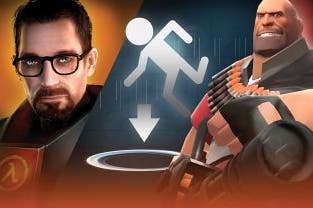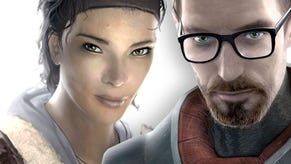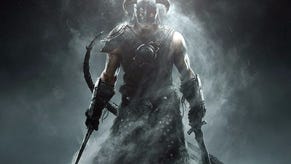How Valve released five of its greatest games in a single day
Ten years on, The Orange Box is still gaming's greatest deal.
The year is 2007. Console owners tap their fingers in barely contained impatience. For years they have been starved of Valve's delicious, full-bodied courses, forced to watch from the bleachers as Valve mixes a unique blend of kinetic first-person with extraordinary tech. Besides a brief dalliance with the original Xbox and the PlayStation 2 - which produce pale imitations of its best work - Valve has remained faithful to the PC.
And then, in a flash, five of them arrive at once; neatly packaged morsels for a new generation reared on Microsoft's sophomore console. Five games, all in one orange box. Valve serves the PC too, for it is October 18 - a day of celebration - and everyone should feast. The Orange Box is out in Europe.
"It would be awesome to say we planned The Orange Box all along," Doug Lombardi tells me, "but it was really more of a creative solution to having three really different products ship at the same time." By 2007, Valve was working on Half-Life 2: Episode 2, the continuation of Gordon's saga, Team Fortress 2, a multiplayer shooter and Portal, a complete unknown.
"Instead of trying to decide which game should go first and thereby setting an arbitrary priority of shipping one over another, the idea of shipping all three together was raised," Lombardi notes. "The idea started to gain traction and the three teams, in effect, became one."
Lombardi explains Valve's thinking at the time, and why it was a product that covered the proverbial bases. "The Orange Box made sense in terms of 'rounding out the offer' for what was a different games market in 2007. Games were still $50 and sold primarily at retail. As such an AAA title at that time needed to have 10 hours of single player content, a multiplayer component, etc. Team Fortress 2 had no single player component, and Episode 2 had no multiplayer. Portal seemed like an entirely new kind of creature, one that challenged us to figure out how to convince players to buy a comedy wrapped inside a first-person puzzle game -- and the length of Portal varied tremendously depending on if you were wired to 'think with portals' or not. Those issues were resolved by having the other two games in the same box."
In fact, Valve didn't stop there. It blew the dust off 2004's Half-Life 2, gave it a polish, and set it down in the package alongside Half-Life 2: Episode One. The latter will always be remembered as a stopgap between better products, but this value-for-money deal was shaping up nicely. Still, hindsight is 20-20 and there was no way of telling whether an odd orange box with cover art depicting a bespectacled scientist and a gun-toting meathead would make a lick of sense. Would the console crowd get it?
"About half the world got it right away, be they on console or PC. We heard things like 'we must be crazy to offer all that content in one box' and 'the best value in gaming'. But the other half of the world seemed deeply confused, and understandably so." Lombardi points out that, even today, compilations are traditionally aimed at hobbyist collectors: you find a bunch of old games stitched together, or an old game re-released in subpar fashion. The idea of new, gleaming titles housed inside that box is a complete anomaly.
Anomaly or not, The Orange Box sailed into Christmas and by 2008 had sold a reported 3 million copies. (That figure today is almost certainly much higher). Dipping back in, what's remarkable is how little the component parts have aged. Entire essays have been written about Half-Life 2, so I won't bore you with more, but I dare you not to be delighted by the electric pop of your pistol the first time you depress the trigger, and the jangle of static as a Combine guard slumps to the floor. It looks fantastic after all this time, and it's the oldest entry of the lot.
In Valve's world, time takes on a different meaning. Their work is almost immortal, their games timeless. I know people who dip back into White Forest in Episode 2, raising a wet finger to the wind to test what an open world Half-Life might have felt like; who shiver at the croaking tones and ghostly visage of the G-Man raising you from stasis hours before. Then there's Team Fortress 2, a game that still enjoys a healthy audience and regular updates.

But even Valve could never have predicted that their guilty pleasure sandwiched at the end of the spread would prove to be the unofficial highlight of the lot. Sure, Portal is brief - a couple of hours, maybe longer if you're on the beers - but it's also subversive, spectacular, and feels as if it belonged in Valve's universe all along. Did Lombardi know they had a hit?
"Yes and no. On the yes side, the Narbacular Drop team was hired out of DigiPen [a Washington game development university] because they were a group of very promising individuals who had created something that caught the interest of many folks at Valve.
"As it evolved and the narrative pieces were added, we could certainly see from the external playtests that gamers were enjoying it. But there had never been a first person puzzler with dark comedy built entirely upon a somewhat mind bending mechanic. So, in a way, placing it in The Orange Box was a giant hedge."
It proved prescient, and over time, Lombardi believes the strength of the individual titles broke through any communication issues. "Gamers are smart enough to find the titles they like no matter how they are shipped."
Are they? Shipping a game with a complicated marketing spin is almost a no-no. Most are stripped bare in overblown YouTube trailers, losing their lustre before they're even prised from their cellophane packaging. Valve let The Orange Box into the wild with a couple of trailers and knew that word of mouth spread like wildfire as reviewers plumbed the Thesaurus to find words to sum up just how good it was. It seems like a distinctly Valve-ian luxury. Buck the trend and win anyway.
The good news is that Valve see it as a win too, which can only mean there's the chance we'll get more down the line. "When [The Orange Box] shipped, it was hard to see it as anything other than crazy. Three different games, three different platforms, plus the two older titles. [It was] quite an effort for everyone. But, over time, the individual titles all reached tremendous success, which was the point all along. So it was worth it."
Worth it? As a consumer, it was the best $50 I ever spent. There's little point in even bringing up Half-Life 3 anymore, but I do put to Lombardi whether The Orange Box 2 is on the horizon. Across the Atlantic, the silence is deafening, and suddenly, I'm back to 2007, a console gamer staring through a one-way window, hand cupped, waiting for scraps.






